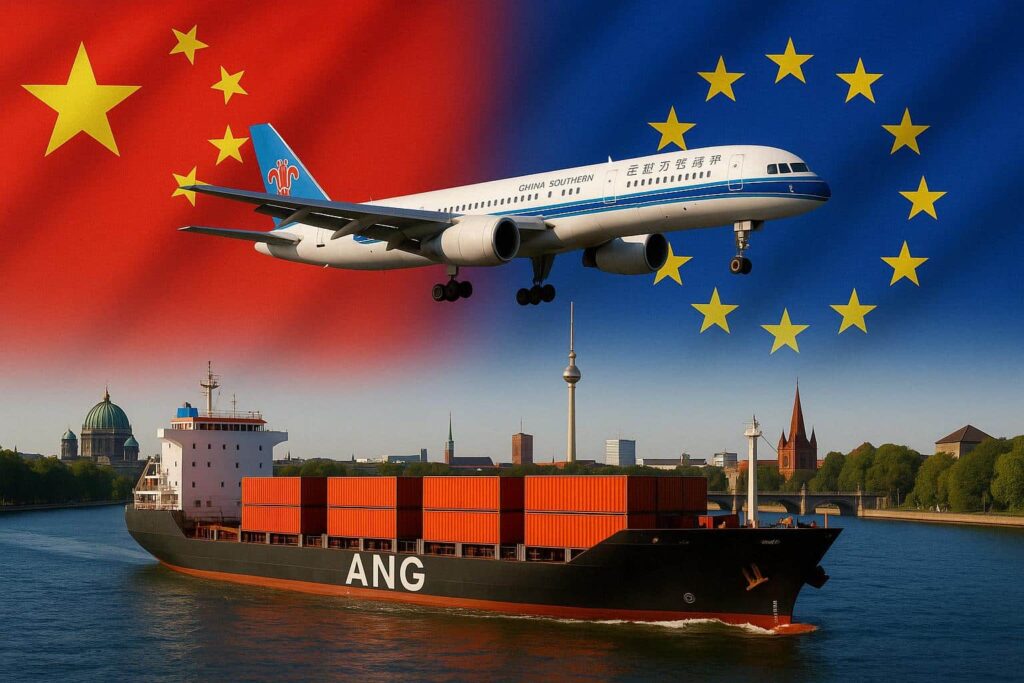- By TOP CHINA FREIGHT
- October 11, 2025
- Shipping
Table of Contents
The time to ship textiles from China to Europe plays a vital role in the apparel and fashion supply chain. Whether you’re a small brand sourcing fabrics or a large retailer importing garments, timing affects your costs, production cycles, and sales windows. With multiple transport options—sea, air, and rail—the right choice can balance speed, budget, and reliability. Understanding these timelines helps importers avoid delays, plan inventory efficiently, and stay competitive in the fast-paced European market.

What Is the Average Time to Ship Textiles from China to Europe?
On average, shipping textiles from China to Europe takes between 10 to 45 days, depending on the mode of transport and customs handling.
| Shipping Method | Average Transit Time | Typical Use | Cost Level | Reliability |
|---|---|---|---|---|
| Air Freight | 5–10 days | Urgent or high-value fabrics | $$$ | High |
| Rail Freight | 18–25 days | Balanced option for textiles | $$ | High |
| Sea Freight | 30–45 days | Bulk textile shipments | $ | Medium |
However, timing can vary based on origin and destination cities, customs inspections, and seasonal congestion. For instance, shipments from Shanghai to Rotterdam often move faster than those from inland cities like Chengdu or Xi’an due to easier port access.
Why Does Shipping Time Matter for Textile Importers?
In the textile industry, timing equals opportunity. Retailers depend on quick turnover to match seasonal demand, while manufacturers must synchronize material arrivals with production schedules.
Delays in textile shipping from China to Europe can cause:
- Missed fashion season launches
- Higher warehousing costs
- Disrupted production lines
- Overstock or understock issues
Therefore, balancing transit time with freight cost is essential for sustaining profitability and meeting market demand on time.
How Does Sea Freight Affect Textile Shipping Time?
Sea freight remains the most popular method for bulk textile transport due to its cost-effectiveness. However, it’s also the slowest.
Key details:
- Average duration: 30–45 days
- Ideal for: Fabrics, yarn, clothing in large volumes
- Common ports: Shanghai, Ningbo, Shenzhen → Rotterdam, Hamburg, Antwerp
Factors influencing sea freight time:
- Port congestion during peak seasons
- Weather disruptions in the Indian Ocean or Suez Canal
- Transshipment delays at hub ports
Pros and Cons of Sea Freight for Textiles
| Pros | Cons |
|---|---|
| Lowest cost per unit | Long transit time |
| Suitable for high-volume goods | Requires advance planning |
| Environmentally friendly | Vulnerable to seasonal delays |
Is Rail Freight from China to Europe Faster?
Yes, rail freight offers a balanced alternative between speed and cost. The China–Europe Railway Express connects key cities such as Chengdu, Wuhan, and Chongqing with European hubs like Duisburg, Warsaw, and Rotterdam.
Transit Time: 18–25 days
Best for: High-value textiles or medium-volume clothing lines
Moreover, rail transport offers stable schedules, fewer disruptions, and efficient customs clearance compared to sea freight. It’s particularly effective for businesses aiming to shorten delivery time without the high cost of air freight.
When Should You Choose Air Freight for Textiles?
Air freight is the fastest but most expensive method. It’s ideal for urgent shipments, seasonal collections, or premium fabrics.
Transit Time: 5–10 days
Typical routes: Shanghai/Guangzhou → Amsterdam/Frankfurt/Paris
Advantages:
- Quick customs clearance
- Reliable transit schedules
- Reduced risk of product damage
However, due to high costs, air freight suits lightweight or time-sensitive textile shipments rather than bulk orders.
How Do Customs and Duty Impact Delivery Time?

Customs clearance significantly affects the time to ship textiles from China to Europe. Documents must be accurate to prevent clearance delays or penalties.
Key Customs Documents Checklist
| Document | Purpose |
|---|---|
| Bill of Lading / Air Waybill | Confirms shipment ownership |
| Commercial Invoice | Declares product value |
| Packing List | Describes goods and weight |
| Certificate of Origin | Verifies product origin |
| Import License (if required) | Grants entry to restricted goods |
Properly managing these documents reduces inspection times and ensures smooth duty handling. Working with an experienced freight forwarder can simplify the process and prevent costly mistakes.
What Are the Fastest Shipping Routes from China to Europe?
The fastest routes generally combine efficient departure and destination points:
| Route | Method | Estimated Time |
|---|---|---|
| Shanghai → Hamburg | Rail | 18–20 days |
| Shenzhen → Rotterdam | Sea | 32–35 days |
| Guangzhou → Paris | Air | 6–8 days |
| Xi’an → Warsaw | Rail | 20–22 days |
| Ningbo → Antwerp | Sea | 34–38 days |
To further optimize speed, avoid overbooked ports and select direct routes with fewer transshipments.
What Factors Can Delay Textile Shipments from China?
Even with precise planning, several factors can affect transit time from China to Europe:
- Peak season congestion (January–March, before Chinese New Year)
- Weather conditions (storms, typhoons, or fog at sea)
- Customs inspection delays
- Carrier capacity issues during global trade surges
- Inland transport bottlenecks between factory and port
Proactive coordination, early booking, and maintaining accurate documentation can significantly minimize these delays.
Case Study: Reducing Lead Time for European Apparel Retailer

A mid-size clothing retailer in France once struggled with inconsistent delivery schedules from China. By switching from sea to rail freight for part of their shipments, they cut transit time by 40% and improved inventory turnover.
They also consolidated supplier pickups in China, which optimized container utilization and lowered inland transport costs. As a result, the company reduced overall lead time from 42 days to 25 days, giving them a stronger position in the fast fashion market.
How to Optimize the Time to Ship Textiles from China to Europe
Combine rail and sea freight for flexibility and savings.
Simplify inland pickup and customs handling.
Avoid peak season surcharges and capacity shortages.
Use real-time tracking to manage arrival schedules proactively.
Align factory schedules with vessel or train departures.
Conclusion
Understanding the time to ship textiles from China to Europe is key to maintaining a reliable and profitable supply chain. Each mode of transport—sea, rail, or air—offers unique benefits in terms of cost and timing. Importers who plan ahead, manage documentation carefully, and choose the right freight partner can significantly reduce delivery times and avoid costly disruptions.
Need a Shipping Quote?
If you want expert guidance and peace of mind, our team is ready to assist.
TJ China Freight offers tailored solutions to help businesses of all sizes ship more reliably from China.

FAQ
Q1: How long does sea freight take for textiles?
Sea freight usually takes 30–45 days. It’s best suited for large-volume textile shipments where cost efficiency is a priority over speed.
Q2: Are rail shipments reliable for textile transport?
Yes. The China–Europe rail network offers stable transit times of 18–25 days, making it a reliable alternative between air and sea freight.
Q3: What documents are needed for textile imports?
Essential documents include the bill of lading, commercial invoice, packing list, and certificate of origin. Some textiles may also require an import license.
Q4: Can customs delay textile deliveries?
Yes. Incomplete or incorrect paperwork can cause delays. To avoid this, ensure all import documents and HS codes are accurate before shipping.
Q5: How can I reduce textile shipping time?
Plan ahead, book early, and choose direct routes. Working with an experienced freight forwarder also helps minimize handling delays.



